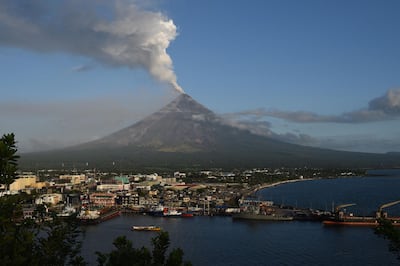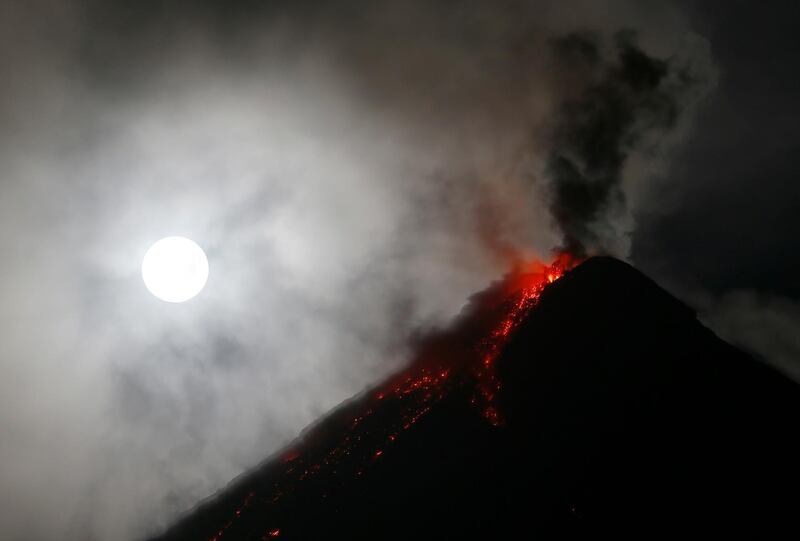Is it safe to return home or not? That’s the question asked repeatedly by tens of thousands of people on the Philippine island of Luzon since Mt Mayon erupted back into life last month.
For the past five weeks, 80,000 have been sheltering in evacuation centres scattered outside the 8km exclusion zone around the volcano.
The conditions are dire: overcrowded, insanitary, swarming with mosquitos.
Yet the alternative is the stuff of nightmares: being scalded, blasted or crushed to death by the ejecta of a volcano in full eruption.
Recently there have been signs that Mt Mayon is calming down. Smoke and gas is pouring from its famously graceful cone, hinting at an escape route for the pressure that drives an explosive outburst.
So now the experts monitoring Mt Mayon face the decision from hell. Do they trust their theories and give the all-clear – or insist that the tens of thousands endure continuing misery in the camps?
For the time being, the Philippine Institute of Volcanology and Seismology (Phivolcs) is erring on the side of caution. As the most active in the Philippines, Mt Mayon is quite capable of springing surprises, having erupted at least 50 times over the last 400 years.
In 1814 it killed over 1,200 people, buried its surroundings in a nine-metre layer of ash and injected enough dust and gas into the atmosphere to trigger a global drop in temperature.
Mt Mayon has already spewed out over 250 million tonnes of debris during the current eruption, and is clearly capable of worse.
And no-one is keen to repeat the dramas playing out on the Indonesian island of Bali.
_____________
Read more:
Afghan farmers replace poppies with pomegranates in war on drugs
Once and for all: is cod liver oil good for you?
Is it worth teaching children mindfulness in schools?
_____________
In September last year, Mt Agung erupted for the first time on over 50 years, prompting the evacuation of over 100,000 people.
By the end of October, the level of activity had declined to the point that the Indonesian authorities lowered the alert level – only to raise it again a month later, leading to the exodus of over 50,000 people.
Earlier this month, scientists again advised that the alert level could be reduced, so that people could return home. Then just days later it had to be restored as Mt Agung erupted again.
No-one wants to play Russian roulette with a volcano. Fortunately, there are signs that scientists are on the brink of a revolution in predicting eruptions.
For decades they have relied on three key indicators: seismic activity around the volcano, analysis of the gases spewing from it, and ground deformation.
All can give clues to what is going on deep inside, but it can come too little too late.
In April 2015 the Calbuco volcano in Chile unleashed the violence of Mt Mayon’s 1814 eruption just two hours after tell-tale signs were detected.
Such events have prompted scientists to look for additional clues to an impending eruption.
Earlier this month, a team led by Professor Jeffrey Johnson at Boise State University, Idaho, described how volcanos emit a characteristic rumble in the build-up to an eruption.
Technically known as infrasound, it’s made up of very low frequency vibrations generated by lava bubbling away inside the volcano.

The team made the discovery during the eruption of another Chilean volcano, Villarrica, in 2015. Shortly before, infrasound detectors had been installed around the volcano, and these detected an increase in the pitch of the rumble.
To find out the cause, aircraft flew over the volcano and took measurements of the lava lake sitting in the cone.
Comparing the two, the team discovered that the infrasound signal was linked to the height of the bubbling lava lake.
Rising up inside the volcano, the sound waves created by the bursting bubbles increased in pitch – the rocky cone changing the note like a vast musical instrument.
As the level of the lake is affected by the inflow of magma beneath the volcano, this change in pitch may give early warning of an impending eruption.
Another source of insight now being studied is a kind of seismic “X-ray”, based on the constant rumble of the whole Earth.
Everything from traffic and mining to ocean waves creates so-called seismic noise. At any given place, it’s entirely random, but when it flows through objects its characteristics change, revealing hidden structure.
Now a team led by PhD student Clare Donaldson at the University of Cambridge, UK, has found that measuring seismic noise at different places around a volcano can reveal changes in its shape.
In tests on Kilauea, a notoriously active volcano in Hawaii, the team detected the flow of magma in and out of a reservoir using the changes in seismic noise. These were followed by changes in the volcano’s shape, reflecting events taking place kilometres below ground.
Like infrasound, this technique could one day be used to keep watch on active volcanoes, giving early warning of future eruptions.
The biggest challenge facing would-be forecasters of eruptions is that every volcano is different. Each contains its own byzantine arrangement of tunnels, chambers and fissures, so that early warning systems that work with one could prove tragically misleading with another.
Tiny crystals the size of salt grains may hold the key to using the right early warning system.
Known as antecrysts, they are formed from magma trapped below volcanoes thousands of years before they erupt.
Like tree-rings, their structure seals in a record of conditions within the magma in the run-up to an eruption.
Using laser analysis of antecrysts, Dr Teresa Ubide of the University of Queensland, Australia and colleagues have worked out the history of magma travelling into Mt Etna in Sicily – Europe’s most active volcano.
This revealed that when magma flows into chambers as much as 10km below Mt Etna, an eruption can be just two weeks away.
Volcanoes and humans have lived in close proximity since the dawn of history. Finally, there is real hope of understanding our moody neighbours and knowing when it’s best to give them some space.
Robert Matthews is Visiting Professor of Science at Aston University, Birmingham, UK






